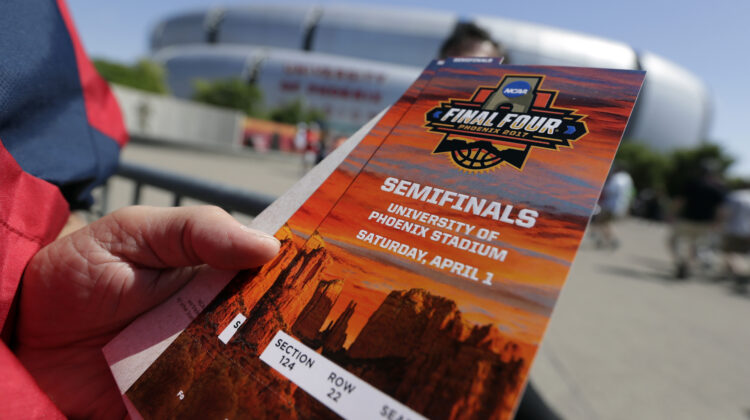By Alex Simon
It’s been two years since, arguably, the greatest March Madness in Pac-12 history.
On the men’s side, all five schools (Colorado, Oregon, Oregon State, UCLA and USC) that made the Big Dance in the Indianapolis bubble won at least one game. The conference had four schools in the Sweet 16, three in the Elite Eight and one, UCLA, in the Final Four.
Down in San Antonio for the women’s tournament, things were even better. Six schools (Arizona, Oregon, Oregon State, Stanford, UCLA and Washington State) went dancing, with five winning a game, three making the Sweet 16 and two, Stanford and Arizona, going all the way to an all-Pac-12 national championship game.
Between the two tournaments, Pac-12 schools picked up 28 wins in 2021.
But the financial impact of those wins on the conference, in a financial sense, couldn’t be any different.
On the men’s side, the Pac-12 brought home nearly $40 million from the 2021 tournament.
On the women’s side? $0.
The reason is the unit system, which sends about 19.5% of the $867.5 million received for the TV rights to the men’s tournament — or $168.8 million — into what’s called the Basketball Performance Fund (BPF).
The BPF awards one unit to a conference for each game played by its teams (except for the national championship). Those units are pooled and carried forward for six years. Each unit has a dollar value that increases by about three percent each year of the payout cycle.
For the men’s side, the Pac-12 received 19 units in 2021, and using figures provided to the Hotline by the NCAA, each unit was worth $2,034,061 over the six years.
Take that amount, multiply it by 19 units and you get $38,647,159 for the conference just from the 2021 men’s tournament performance. Split that up by the 12 schools and it’s a $3.22 million influx of cash per campus.
That’s a pretty good payout. A system like that has never been implemented on the women’s side.
But after the many issues surrounding the 2021 women’s tournament — which were brought to light by Pac-12 people, like Oregon basketball player Sedona Prince and Stanford athletic trainer Ali Kershner — the NCAA hired a law firm to review gender equity issues.
The report found that the current NCAA television deal, which packages the women’s tournament with 28 other NCAA championships for an average amount of $34 million, significantly undersells the value of the women’s basketball rights.
In fact, estimates show that the women’s tournament on its own could be worth “between $81 and $112 million annually beginning in 2025.”
That estimate seems to support the idea that women’s basketball could be considered a self-sufficient sport by the NCAA. And, if the money’s there, several prominent coaches would support a unit system on the women’s side, like the men’s.
“I think it’s a good idea to do,” said Tara VanDerveer, head coach at Stanford and 2021 national champion.
You can also count South Carolina coach Dawn Staley and UCLA coach Cori Close as coaches in favor of the unit system. They see it as a way for women’s basketball programs to help other athletic programs, too.
“We’re at that place where we’re in high demand,” Staley said. “I do believe that women’s basketball can stand on its own and be a huge revenue-producing sport that can do, to a certain extent, what men’s basketball has done for all those other Olympic sports.”
Close, who is also the president of the Women’s Basketball Coaches Association, added:
“I don’t think any of us are asking to be just like the men, obviously they’re ahead of us in that deal … We want to grow the pie. I think it’s more of an opportunity. It’s an opportunity to be a valuable resource on our campuses.”
Staley and VanDerveer both made note of the increased attention towards the women’s game, both with crowds — the first weekend set an NCAA attendance record — and on television, with ESPN reporting viewership was up 28% from last year for first and second round games.
It’s why all signs point to a separate media deal for the women’s tournament and, potentially, a unit system that VanDerveer would support.
“When you attach money to something, it attaches importance to it. And so if there are units, then that’s saying it’s important. And I think that is important,” VanDerveer said. “But, when we keep doing the things that we’re doing, we’re not really putting our money where our mouth is.”
Stanford has been the standard bearer for the Pac-12 on the women’s side, with its 100th NCAA Tournament victory coming in this year’s first round.
When asked about the benefits of bringing the unit system to the women’s side of basketball, VanDerveer quipped, “Do some math and figure out how much we would have made.”
While it would be difficult to do the math for all 100 wins, we can spotlight 2021 as a specific example. It isn’t totally clear what the exact unit system would be, but for the sake of an estimate, let’s mirror the men’s structure.
Using the high end of the gender equity review’s estimate of $112 million and the same unit setup as the men (with the BPF just under 19.5% of the television revenue), a women’s BPF would be worth $21,793,199.
A men’s unit in 2022 was $338,211 – around 0.2% of the BPF.
If we use the same scale, a women’s basketball unit for 2022 would be worth $43,655.
For the sake of simplicity, we will not add the 3 percent increase to each season. But even taking that one unit and multiplying it by six seasons, a unit’s full worth is $261,930.
Remember the numbers up top, about how well the Pac-12 did in the 2021 women’s tournament? That performance would have been good for 18 units.
So the hypothetical total for the Pac-12 in 2021 would be $4,714,740.
Divide that up among the schools evenly and each athletic department would get $392,895.
It’s not in the millions. But it’s a whole lot more than zero.
I called VanDerveer with the math this week after Stanford’s stunning upset loss to Ole Miss. The coach still insisted I try to go all the way back to when the unit system began and map out how much money the Stanford women could have made for the Pac-12 if the unit system always mirrored the men.
But when told the number from the hypothetical 2021 year, her reaction was simple.
“That’s significant,” VanDerveer said. “That’s significant, don’t you think?”
VanDerveer has been a vocal supporter of the conference for a long time now. She even has her own program following that mindset, with Stanford players cheering on every Pac-12 school named during the selection show and players like Haley Jones closely following other Pac-12 games on their off days.
Even though Stanford is surprisingly not in the Sweet 16 for the first time since 2007, three Pac-12 schools are: Colorado, UCLA and Utah.
VanDerveer is fully rooting for all three, even sending texts to the three head coaches there.
“Just wishing them good luck and to represent,” she said. “We want them to do well.”
Perhaps as soon as two years from now, the conference’s schools can benefit from that success financially, too.
Support the Hotline: Receive three months of unlimited access for just 99 cents. Yep, that’s 99 cents for 90 days, with the option to cancel anytime. Details are here, and thanks for your support.
*** Send suggestions, comments and tips (confidentiality guaranteed) to pac12hotline@bayareanewsgroup.com or call 408-920-5716
*** Follow Alex Simon on Twitter: @AlexSimonSports
*** Pac-12 Hotline is not endorsed or sponsored by the Pac-12 Conference, and the views expressed herein do not necessarily reflect the views of the Conference.
Related posts:

(AP Photo/Marcio Jose Sanchez)
Business of Sports – Say what? Commissioner George Kliavkoff believes the Pac-12 will “catch” the Big Ten, SEC in media revenue. Allow us to explain
(AP Photo/Ralph Freso, File)
College Football Playoff expansion to begin in 2024 after Rose Bowl relents: Early start a boost for the Pac-12 The Pac-12 top 10: Key storylines from a wild week of staff hires, player departures, AD tweets
The Pac-12 top 10: Key storylines from a wild week of staff hires, player departures, AD tweets 
San Francisco 49ers quarterback Brock Purdy (AP Photo/Stephen Brashear)
The Basha high grad who helped on Brock Purdy’s journey
